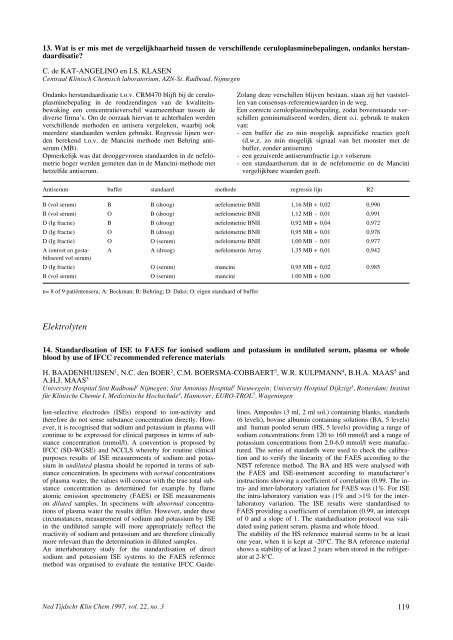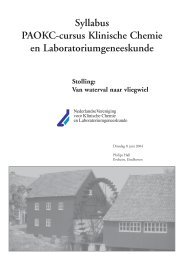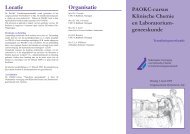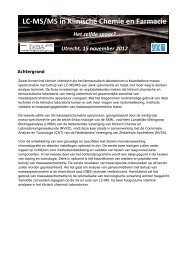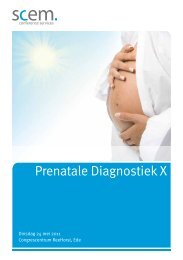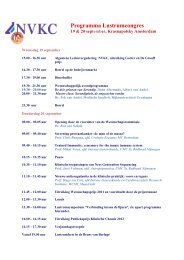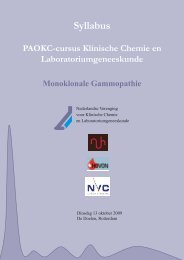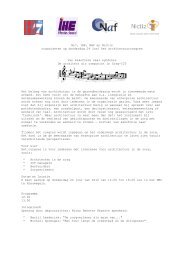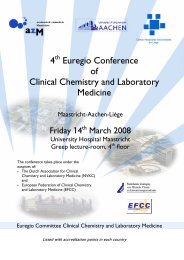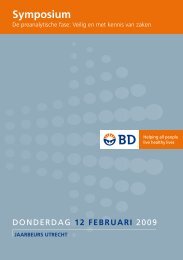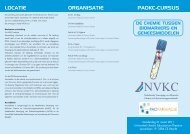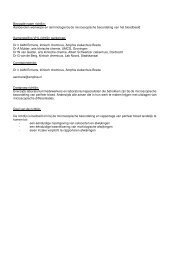Klinische (bio)chemie en methodologie - NVKC
Klinische (bio)chemie en methodologie - NVKC
Klinische (bio)chemie en methodologie - NVKC
You also want an ePaper? Increase the reach of your titles
YUMPU automatically turns print PDFs into web optimized ePapers that Google loves.
13. Wat is er mis met de vergelijkbaarheid tuss<strong>en</strong> de verschill<strong>en</strong>de ceruloplasminebepaling<strong>en</strong>, ondanks herstandaardisatie?<br />
C. de KAT-ANGELINO <strong>en</strong> I.S. KLASEN<br />
C<strong>en</strong>traal Klinisch Chemisch laboratorium, AZN-St. Radboud, Nijmeg<strong>en</strong><br />
Ondanks herstandaardisatie t.o.v. CRM470 blijft bij de ceruloplasminebepaling<br />
in de rondz<strong>en</strong>ding<strong>en</strong> van de kwaliteitsbewaking<br />
e<strong>en</strong> conc<strong>en</strong>tratieverschil waarneembaar tuss<strong>en</strong> de<br />
diverse firma’s. Om de oorzaak hiervan te achterhal<strong>en</strong> werd<strong>en</strong><br />
verschill<strong>en</strong>de method<strong>en</strong> <strong>en</strong> antisera vergelek<strong>en</strong>, waarbij ook<br />
meerdere standaard<strong>en</strong> werd<strong>en</strong> gebruikt. Regressie lijn<strong>en</strong> werd<strong>en</strong><br />
berek<strong>en</strong>d t.o.v. de Mancini methode met Behring antiserum<br />
(MB).<br />
Opmerkelijk was dat drooggevror<strong>en</strong> standaard<strong>en</strong> in de nefelometrie<br />
hoger werd<strong>en</strong> gemet<strong>en</strong> dan in de Mancini-methode met<br />
hetzelfde antiserum.<br />
Ned Tijdschr Klin Chem 1997, vol. 22, no. 3<br />
Zolang deze verschill<strong>en</strong> blijv<strong>en</strong> bestaan, staan zij het vaststell<strong>en</strong><br />
van cons<strong>en</strong>sus-refer<strong>en</strong>tiewaard<strong>en</strong> in de weg.<br />
E<strong>en</strong> correcte ceruloplasminebepaling, zodat bov<strong>en</strong>staande verschill<strong>en</strong><br />
geminimaliseerd word<strong>en</strong>, di<strong>en</strong>t o.i. gebruik te mak<strong>en</strong><br />
van:<br />
- e<strong>en</strong> buffer die zo min mogelijk aspecifieke reacties geeft<br />
(d.w.z. zo min mogelijk signaal van het monster met de<br />
buffer, zonder antiserum)<br />
- e<strong>en</strong> gezuiverde antiserumfractie i.p.v volserum<br />
- e<strong>en</strong> standaardserum dat in de nefelometrie <strong>en</strong> de Mancini<br />
vergelijkbare waard<strong>en</strong> geeft.<br />
Antiserum buffer standaard methode regressie lijn R2<br />
B (vol serum) B B (droog) nefelometrie BNII 1,16 MB + 0,02 0,990<br />
B (vol serum) O B (droog) nefelometrie BNII 1,12 MB - 0,01 0,991<br />
D (Ig fractie) B B (droog) nefelometrie BNII 0,92 MB + 0,04 0,972<br />
D (Ig fractie) O B (droog) nefelometrie BNII 0,95 MB + 0,01 0,978<br />
D (Ig fractie) O O (serum) nefelometrie BNII 1,00 MB - 0,01 0,977<br />
A (ontvet <strong>en</strong> gestabiliseerd<br />
vol serum)<br />
A A (droog) nefelometrie Array 1,35 MB + 0,01 0,942<br />
D (Ig fractie) O (serum) mancini 0,95 MB + 0,02 0,985<br />
B (vol serum) O (serum) mancini 1.00 MB + 0,00<br />
n= 8 of 9 patiënt<strong>en</strong>sera; A: Beckman; B: Behring; D: Dako; O: eig<strong>en</strong> standaard of buffer<br />
Elektrolyt<strong>en</strong><br />
14. Standardisation of ISE to FAES for ionised sodium and potassium in undiluted serum, plasma or whole<br />
blood by use of IFCC recomm<strong>en</strong>ded refer<strong>en</strong>ce materials<br />
H. BAADENHUIJSEN 1 , N.C. d<strong>en</strong> BOER 2 , C.M. BOERSMA-COBBAERT 3 , W.R. KULPMANN 4 , B.H.A. MAAS 5 and<br />
A.H.J. MAAS 5<br />
University Hospital Sint Radboud 1 Nijmeg<strong>en</strong>; Sint Antonius Hospital 2 Nieuwegein; University Hospital Dijkzigt 3 , Rotterdam; Institut<br />
für <strong>Klinische</strong> Chemie I, Medizinische Hochschule 4 , Hannover; EURO-TROL 5 , Wag<strong>en</strong>ing<strong>en</strong><br />
Ion-selective electrodes (ISEs) respond to ion-activity and<br />
therefore do not s<strong>en</strong>se substance conc<strong>en</strong>tration directly. However,<br />
it is recognised that sodium and potassium in plasma will<br />
continue to be expressed for clinical purposes in terms of substance<br />
conc<strong>en</strong>tration (mmol/l). A conv<strong>en</strong>tion is proposed by<br />
IFCC (SD-WGSE) and NCCLS whereby for routine clinical<br />
purposes results of ISE measurem<strong>en</strong>ts of sodium and potassium<br />
in undiluted plasma should be reported in terms of substance<br />
conc<strong>en</strong>tration. In specim<strong>en</strong>s with normal conc<strong>en</strong>trations<br />
of plasma water, the values will concur with the true total substance<br />
conc<strong>en</strong>tration as determined for example by flame<br />
atomic emission spectrometry (FAES) or ISE measurem<strong>en</strong>ts<br />
on diluted samples. In specim<strong>en</strong>s with abnormal conc<strong>en</strong>trations<br />
of plasma water the results differ. However, under these<br />
circumstances, measurem<strong>en</strong>t of sodium and potassium by ISE<br />
in the undiluted sample will more appropriately reflect the<br />
reactivity of sodium and potassium and are therefore clinically<br />
more relevant than the determination in diluted samples.<br />
An interlaboratory study for the standardisation of direct<br />
sodium and potassium ISE systems to the FAES refer<strong>en</strong>ce<br />
method was organised to evaluate the t<strong>en</strong>tative IFCC Guide-<br />
lines. Ampoules (3 ml, 2 ml sol.) containing blanks, standards<br />
(6 levels), bovine albumin containing solutions (BA, 5 levels)<br />
and human pooled serum (HS, 5 levels) providing a range of<br />
sodium conc<strong>en</strong>trations from 120 to 160 mmol/l and a range of<br />
potassium conc<strong>en</strong>trations from 2.0-6.0 mmol/l were manufactured.<br />
The series of standards were used to check the calibration<br />
and to verify the linearity of the FAES according to the<br />
NIST refer<strong>en</strong>ce method. The BA and HS were analysed with<br />
the FAES and ISE-instrum<strong>en</strong>t according to manufacturer’s<br />
instructions showing a coeffici<strong>en</strong>t of correlation (0.99. The intra-<br />
and inter-laboratory variation for FAES was (1%. For ISE<br />
the intra-laboratory variation was (1% and >1% for the interlaboratory<br />
variation. The ISE results were standardised to<br />
FAES providing a coeffici<strong>en</strong>t of correlation (0.99, an intercept<br />
of 0 and a slope of 1. The standardisation protocol was validated<br />
using pati<strong>en</strong>t serum, plasma and whole blood.<br />
The stability of the HS refer<strong>en</strong>ce material seems to be at least<br />
one year, wh<strong>en</strong> it is kept at -20°C. The BA refer<strong>en</strong>ce material<br />
shows a stability of at least 2 years wh<strong>en</strong> stored in the refrigerator<br />
at 2-8°C.<br />
119


